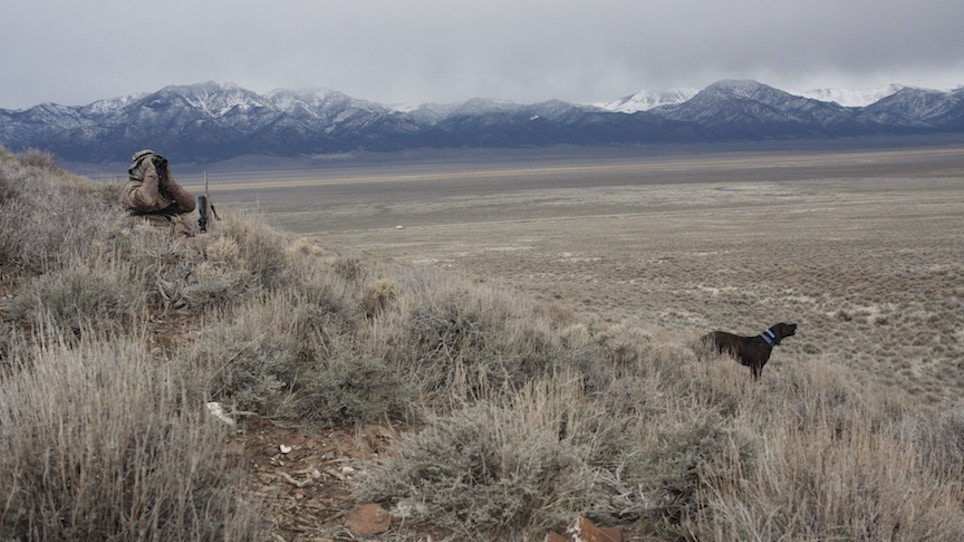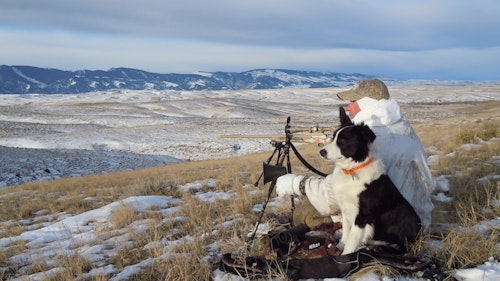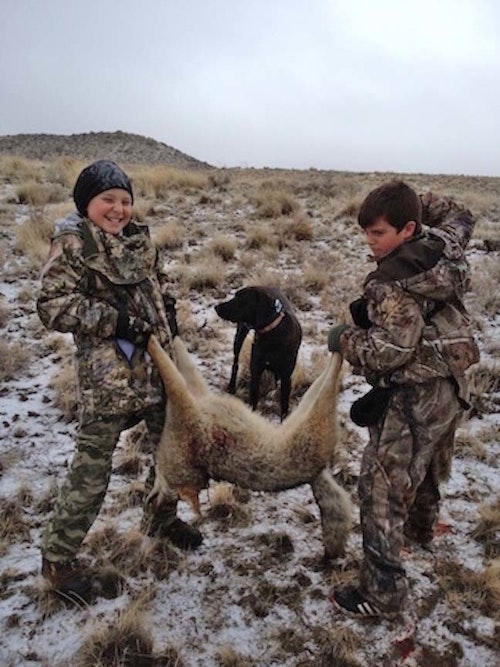
Tolling dogs add a whole new dimension to hunting coyotes, with a fun factor that's off the charts. (Gordy Krahn photo)
Joey could loosely be defined as a reluctant tolling dog. Born, bred and trained to hunt the waterfowl and grouse my brother Tony pursues with great enthusiasm near his home in northern Minnesota, I wouldn’t describe the 80-pound yellow Lab as aggressive, but he is pretty damn cock sure. Or at least he was, until he encountered his first pair of coyotes.
Tony was walking Joey and his two older brace mates, Luke and Kobe, a few years back on the backside of his home property after work one evening, as he often does to get the dogs a little needed exercise. The loop usually takes the better part of an hour and, for them, it’s a welcome relief from the cabin fever that often sets in during the dead of winter up north after hunting seasons have all expired.
“It was right at dusk when I got down to the far end of the field behind my house and heard some barking,” Tony said. “It was coming from the southwest and the neighbor’s dogs always bark so I figured it was them. I noticed Joey was no longer with me, but there was nothing unusual about that either. So I just continued walking over to the west and that’s when I realized the barking was on my property — and that it was Joey. But I just figured he had chased a grouse up a tree or something like that.”
Tony walked up to the edge of the woods and called for his dog — and was taken aback by what happened next. “All of a sudden Joey came running out of the woods with his tail between his legs,” he said. “There was one coyote beside him snapping at his face and another coming up behind him trying to grab his back leg. It all happened so quickly. They got about 20 yards from me and the lead coyote looked up and saw me and they both bolted and were gone in a flash. I couldn’t believe it. Now Joey was my smallest Lab but he still weighs 80 pounds. He’s not easily intimidated and those coyotes were half his size, but he had his tail between his legs. I could tell he knew he was in trouble.”
Tony’s guess is that it was a mated pair that was either protecting a kill or their territory. “I went back that weekend and tried to call them but I couldn’t get them to come,” he said. “I had neighbors tell me three times during the next few weeks that they saw coyotes around my place. I continue to walk my dogs down there but haven’t had another encounter.”
This type of interaction is not uncommon when canines meet on the killing fields. There is fierce competition between predators of all sorts as they vie for territorial rights and the resources contained within the boundaries of those territories. Those brainiac biologists who study toothed critters refer to this as interspecific competition—or the war between different species for the possession of available resources. One common canine example is the historical relationship between wolves, coyotes and red foxes. As wolves were extirpated from most of the United States during the late 1880s and early 1900s, it gave coyotes the opportunity to expand eastward from their more traditional Western digs. As they moved eastward, they displaced the smaller red foxes that, in turn, had to seek out new habitat niches to survive. This territoriality is one mechanism whereby the population density of a species is adjusted to the availability of resources — in most cases, food and sanctuary.
So it’s not a stretch to surmise that canines, coyotes in particular, view their domestic cousins (i.e., Fido, Rover … and Joey) as a threat to their territories and competition for the resources they passionately guard. And there in lies the fun, as resourceful fur hunters have put those interactions to play in the form of using decoy, or tolling, dogs to hunt coyotes.
Decoy Dogs
In hunting circles, tolling dogs are most commonly associated with waterfowl hunting — Nova Scotia duck tolling retrievers in particular, a breed that resembles a small golden retriever. These dogs are named for their ability to engage and lure waterfowlwithin shotgun range — a practice referred to as tolling. Basically, the dog acts as a decoy, as it swims around in front of the hunter’s blind while its handler hides in ambush, often throwing a ball or stick to be retrieved. The dog’s unusual activity plays on the curiosity of ducks and geese, and they often swim over to investigate. When the birds draw near, the hunter calls the dog back to the blind and puts the birds to wing, which offers him the shot. The dog then retrieves any downed birds — thus giving it the name of a tolling retriever.
Coyote hunters, too, employ dogs to decoy their canine cousins, and the practice is gaining popularity because of its effectiveness and a fun factor that’s way off the chart. Decoy dogs come in a variety of shapes and sizes and encompass many breeds. While there are favored breeds, no one dog is specifically used for tolling coyotes. Many hunters prefer cur dogs or curs crossed with other breeds, such as hounds or terriers. And there’s a fine line between enough dog and too much dog. Most agree that a decoy dog should be about the size of a coyote only stouter, with the endurance to work all day in rough conditions. While some hunters do use larger dogs, they run the risk of intimidating the coyotes they’re trying the lure in. Most decoy dogs are medium-sized, short-haired — 25 to 50 pounds — dogs. Popular breeds include curs, McNabb shepherds, border collies, Norwegian elkhounds, Australian shepherds and various breeds of terriers. A decoy dog should have a high prey drive and possesses at least some amount of aggression. Much like an upland bird dog, the decoy dog should inherently quarter in front of the hunter, ranging no more than 400 or 500 yards.

Training a decoy dog is similar to training any other type of hunting dog, whether it’s a bird dog, squirrel dog or coon dog. All hunting breeds are hard-wired to perform certain tasks in the field and it’s no different with a tolling dog. From there, it takes basic obedience training, which includes acclimating the dog to firearms, to fine-tune it much the same as training any other hunting breed. Most hunters use an e-collar with a tone feature in the field for recalling the dog. Some hunters will use captive coyotes to familiarize their dogs with these wild canines or take them into denning areas and allow the dog to free range. The basic premise is for the dog to engage the coyotes and then return to the hunter, who will be waiting with shotgun or rifle to give it an enthusiastic reception.
Coyote Control
Animal damage control (ADC) agents have long used dogs to locating coyote denning sites where they would go in and destroy the pups. This was largely done on sheep ranches where depredating coyotes were preying on livestock. These were often referred to as denning dogs. According to a study done by Gary J. Rowley and DeLyle Rowley — “Decoying Coyotes with Dogs” — the use of decoy dogs in ADC operations began in the mid- to late-1960s, when ADC agents would use dogs to engage coyotes at denning sites, “… provoking the defensive and den guarding behavior of coyotes by intruding in their territory and natal area.” According to the study, “Food and energy demands of adult coyotes steadily increase from estrus to weaning. Subsequently, predation on livestock, particularly sheep and goats, also increases. Established territories and den sites are highly defended and protected. Intruding canine species, particularly domestic dogs, are aggressively attacked by coyotes in an effort to provide protection to their young. This display of defensive behavior is effectively used as a strategy to control depredating coyotes.”
But why should the ADC agents have all the fun? More fur hunters are getting into the decoy dog game because they realize it gives them yet another tool in their predator-hunting arsenal. And like upland bird and waterfowl hunters, they recognize that hunting coyotes can be that much more fun and effective with a canine companion.
I hooked up with Cory Lundberg and his dog, Duke — a catahoola/cur cross — a few years ago and experienced hunting with a decoy dog for the first time. I’ve got to say it’s pretty damn cool. Cory confirmed that the use of decoy dogs really plays on the territorial tendencies of coyotes, especially during the spring when they’ve got pups on the ground. “During this time, the alpha males are extremely territorial,” he said. “And the best way to get some action is by primarily using challenge howls, barks and yips, or mimicking the sounds of a family of pups and females with an electronic caller.” It’s also the best time, he says, to employ a decoy dog to further exploit those defensive tendencies.
Cory got into the game when he hooked up with a government trapper in Wyoming who was using decoy dogs to hunt depredating coyotes. “It was June and he was mouth howling for coyotes — no calls, nothing else. And I’m like, What’s this guy doing? But sure enough, this coyote popped up its head, saw the dogs and came over to check them out. Just like that, we had a coyote on the ground. And I thought, That’s pretty cool! Later, we found a den on a big flat, and the female and last year’s pups were sitting on the den and they started barking and howling at his dogs. Then I heard the male howl about a mile away, out in the flats. Anyway, his two dogs took off toward the den and I’ve never seen a coyote cover ground so fast. When the male got there, he and the dogs started doing figure eights and nipping at each other. It almost looked liked they were playing. The coyote seemed more curious about the dogs then anything else. I just stood there and watched. I couldn’t get over how the coyote just couldn’t get his attention off the dogs. The dogs came back over to us in about 10 minutes and the male coyote followed them back in until he was just 15 yards from me. He’d look at me and then look at the dogs. Typically, a coyote would have bailed but he was just fixated on the dogs.”
Cory said it wasn’t long after that that he decided to get his first decoy dogs — Max and Annie. Lundberg’s current dog, Duke, is somewhat unique in that he’s trained to sit close and howl when Cory howls, which adds an additional layer of intrigue. When Duke spots a coyote coming in, he casts out and engages it. Once he has the coyote’s attention he then turns and comes back to his owner, luring the coyote into shooting range. “I’ve seen other dogs that bark when they’re out there but Duke’s the only one I’ve seen that goes out there and howls,” Cory said. “It’s just something he does.”
Cory says that using a decoy dog adds a whole other dimension to hunting coyotes, and in many ways is like hunting with a bird dog because it gives you another advantage. “Obviously, dogs have a very good sense of smell and they can pick up on coyotes you don’t see,” he said. “And whether it’s a territorial thing or just curiosity they’re drawn to the dog. I’ve had guys out with me and Duke will go out after the coyotes and they’ll turn around and leave and act like they’re going to take off. The hunters always say, ‘Hey, he’s chasing them away!’ I have to tell them to calm down and I use the tone on the e-collar to reel Duke back in. And sure enough, the coyotes usually stop and then follow him back in.”
Cory says that the beauty of it is that if there are two or more coyotes and you shoot one the dog will go over and start chewing on it. “You know, like a bird dog going out to get the bird,” he said. “Oftentimes, the other coyote looks over and thinks, Hey, that dog is beating up my buddy, and he comes back to defend the other coyote. You can get doubles and triples that way, where without the dog in play they would have just run off.”
The Perfect Partner
Another Western hunter, Mark Kayser, got into the decoy dog game basically because he wanted a hunting companion that was as dedicated to the game as he is. And while Mark knows how effective hunting with a decoy dog can be during the denning period, he’s a fur hunter and most of his coyote hunting takes place during the winter when pelts are prime. “I got interested in decoy dogs talking with animal damage control (ADC) guys and watching some videos. But I’m a fur hunter not an ADC agent who hunts to do damage control,” he said. “I just wanted a dog that would be a hunting partner.”

Mark’s main decoy dog for the past several years is a stout 42-pound border collie named Sage. Last year he added another border collie, Sully, to the Kayser pack. “We were in the market for a versatile dog that could pull multiple duties,” he said about settling in on the family’s first decoy dog. “We thought about getting a family dog that could do 4H dog stuff with the kids, maybe hunt shed antlers and that I could use as a decoy dog for hunting coyotes.
“I knew that if I was going to take it coyote hunting it had to know commands, because any dog can get in trouble if the coyote is bold enough and starts to go after them,” Mark said. “So I immediately went to work bonding with and training the dog. I worked with hand controls, so I could whistle to get her attention and she’d stop and look back and then I could use hand signals get her to sit, come, whatever. I also had to break her into firearms so she wouldn’t be gun shy just like you would with any bird dog.”
Mark says he doesn’t necessarily want his dogs to engage coyotes, but basically just wants them to be a moving decoy. “I use a lot of coyote vocalizations, and I do a lot of my hunting at dawn and at dusk,” he said. “And I figure that even though my dogs are black and white, coyotes have good eyesight and even in that dim light and the sage brush and grass, if they’re out in front of me they’ll see that motion and might come over to investigate. But nine times out of 10 I just have them sitting beside me because if a coyote’s coming I don’t see any reason for the dog to engage it.
“A few years ago, I had a coyote that was circling wide and it just wouldn’t come in,” Mark said. “My hunting partner was to the left of me and my son, Cole, was right beside me. It was circling to my partner’s side out of effective shooting range, and I thought, Screw this, I want Cole to get the shot. So I told Sage to ‘get him.’ She had seen the coyote coming across this huge reservoir and she took off after him. The coyote saw her and stopped. My buddy shot, but the bullet sailed high. At that point Sage and that coyote were just locked on to each other and on a collision course. They were going to duke it out. The coyote kept coming — the shot hadn’t affected it. My buddy shot at the moving target but missed high again. But the third shot hit the coyote right in the head. We found out later that his gun was shooting about 8 inches high. But what amazed us was that the coyote was completely unfazed by the rifle shots and was ready to engage the dog. This is a perfect example of how a decoy dog can be a benefit.”
But Mark cautions that sometimes using a dog can have a negative effect. “I can recall several different times when coyotes came out on a ridge and stopped at 400 or 600 yards and just sat there listening to the call but wouldn’t come in,” Mark said. “So after a little while of playing games with them I’d send Sage out because I figured I needed to try something, especially if it was getting close to dark. And the negative is that if they’re paranoid coyotes, they’ll just turn around and leave cause they don’t want anything to do with another canine.”
Hunting coyotes using a decoy dog is really not much different from pursuing game — whether it’s beast or fowl — with any breed of hunting dog. It’s about adding another skill set to the equation by utilizing the dog’s senses and hard-wired talents to procure more game. For fur hunters, the payoff can be considerable and adds a whole new dimension to the hunt by exploiting the inherent social interaction between competitive canine species. And, in the end, it’s just one more tool the predator hunter can use put more fur in the back of the truck.






